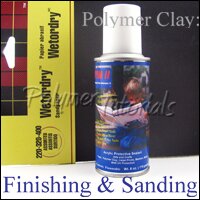How to Finish Polymer Clay Items
Polymer clay items may be left as is after baking, painted with various paints, and/or covered with acrylic glazes or epoxy resin. They may also be sanded and buffed before and/or after applying the glaze. |
 |
Highly detailed sculptural pieces as well as those with rich or intentionally rough textures do not need to be sanded. If you would like to make the texture and sculptural details more visible, they may be antiqued by adding patina. To create patina on polymer clay, use acrylic or oil-based paints in colors either darker or lighter than the main color of your piece. To add patina, cover your piece with the paint, and then remove most of it with paper towel or a slightly wet sponge.
Sanding and Buffing
Many designs in polymer clay look better (more professional and refined) after sanding and buffing.
To achieve high-gloss surface, use multiple grids of sand paper, starting with the lowest grit. You will need sand paper with grits from 320 to 800 (some polymer clay artists recommend even a higher number, and some say that as low as 600 is good enough).
Wet sanding is recommended to prolong the life of sand paper and to avoid dust. You may use running water or a water bath (a drop of liquid soap or dish detergent may be added to the water bath to reduce surface tension).
Buff the sanded surface of your polymer clay item on a piece of rough cotton (old jeans are ideal for this task).
Dry the sanded and buffed polymer clay item thoroughly before applying any glaze.
Applying Glaze
Applying glaze to your finished polymer clay items is optional. It does not really protect your polymer clay item. What it does, it either adds more shine to your sanded polymer clay piece (if you are using gloss finish), or it reduces the shine (if satin finish is used). Neither of these finishes works as a substitute for sanding. If you are applying glaze, you do need to sand your polymer clay creation first.
Sculpey glaze is available in satin or gloss finish (at about $3.50 for 2 oz.). Alternatively, water-based clear gloss for hardwood floors may be used (such as Varathane or Future). The most economical option (if you anticipate a lot of use) is 1 gallon (128 fl.oz.) of floor finish for about $50.00.
To cover your creation with the glaze, you may use a brush and paint the glaze on, or you may dip your polymer clay item into the glaze.
- To avoid trapping the air in your brush, prepare the brush by dipping it in water first, then squeeze the excess of water out and use it to apply the glaze. Place the brush in water immediately when you are done and wash and dry it thoroughly after each session.
- When using the dip-in method, the trickiest part is removing an excess of the glaze from your polymer clay items. Turn them often during the first few minutes of drying.
- The highest gloss is achieved if the glaze is applied to a cool polymer clay surface. Applying the glaze to the polymer clay item hot from the oven will result in a satin finish.
- Multiple layers of the glaze may be applied. Allow your polymer clay item to dry completely between applying the layers of the glaze. You may oven-seal the glaze at 200°F for about 10 minutes after each application, but it is not necessary. Make sure the glaze is completely dry before placing the polymer clay item back in the oven!
The glazed surface may be sanded and buffed, if desired.
Many of the difficulties described above may be avoided by using a spray-on type of glaze. My new favorite for this task is PYM II spray (available online).
Applying Resin
While glaze cannot be used in place of sanding, a two-part epoxy resin can. One layer of this resin is equal to about fifty layers of a regular glaze, so it works perfectly to level out and hide any surface imperfections your polymer clay piece may have. The only down side of using the resin for me is that it can only be applied to flat surfaces. So, you will not be able to cover spherical beads with this resin, but it does wonders when applied over a flat polymer clay pendant, for example.
To learn how to work with two-part epoxy resins, please refer to my step-by-step tutorial on this subject.


